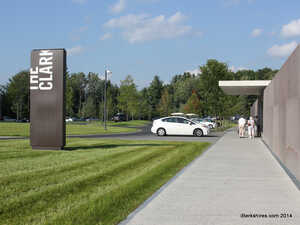Clark Opening Lecture for 'Trembling Earth' Exhibit
WILLIAMSTOWN, Mass.— On Saturday, June 10, in conjunction with the opening of its newest exhibition, "Edvard Munch: Trembling Earth," the Clark Art Institute hosts a lecture by Jay A. Clarke, the exhibition curator and Rothman Family Curator, Art Institute of Chicago, in its auditorium at 11 am.
Free; no registration is required.
According to a press release:
"Edvard Munch: Trembling Earth" is the first exhibition in the United States to consider how the noted Norwegian artist Edvard Munch (1863–1944) employed nature to convey meaning in his art. Munch is regarded primarily as a figure painter, and his most celebrated images (including his iconic The Scream) are connected to themes of love, anxiety, longing, and death. Yet, landscape plays an essential role in a large portion of Munch's work. Edvard Munch: Trembling Earth considers this important, but less explored aspect of the artist's career.
Trembling Earth features more than seventy-five objects, ranging from brilliantly hued landscapes and three stunning self-portraits, to an extensive selection of his innovative prints and drawings, including a lithograph of Munch's most celebrated work, The Scream. The exhibition includes more than thirty works from the Munch Museum's world-renowned collection, major pieces from other museums in the USA and Europe, and nearly forty paintings, prints, and drawings from private collections, many of which are rarely exhibited.
On Friday, June 9 at 7:30 pm, the Clark hosts an opening reception. Visitors are invited to enjoy light refreshments and be among the first to view the exhibition.
Edvard Munch: Trembling Earth is co-organized by the Clark Art Institute, Williamstown, Massachusetts; the Museum Barberini, Potsdam, Germany; and Munchmuseet, Oslo, Norway, and curated by Jay A. Clarke, Rothman Family Curator, Art Institute of Chicago; Jill Lloyd, independent curator; and Trine Otte Bak Nielsen, curator, Munchmuseet. Generous funding for presentation at the Clark and Munchmuseet is provided by the Asbjorn Lunde Foundation, Inc.
This exhibition is made possible by Diane and Andreas Halvorsen. Major funding is provided by Carol and Richard Seltzer, with additional support from Lady Gibbons, Robert D. Kraus, the S & L Marx Foundation, and the Norwegian Consulate General, New York. This exhibition is supported by an indemnity from the Federal Council on the Arts and the Humanities.
Tags: Clark Art,

